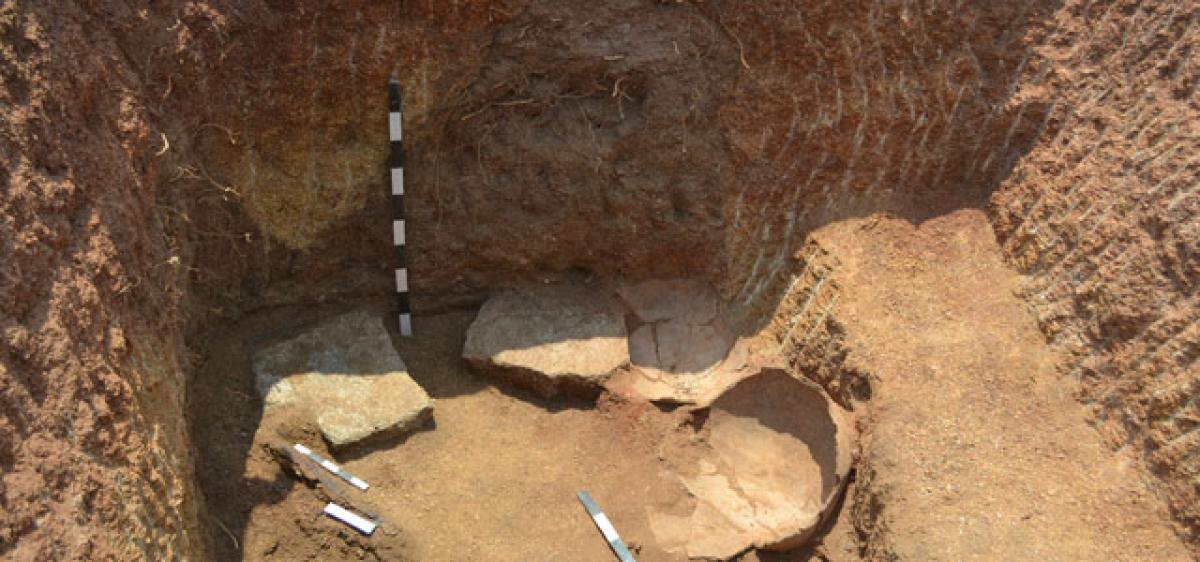Live
- PM Modi pays homage to ‘the great’ Balasaheb Thackeray on his death anniversary
- One who cares for Delhi will not stay with gang of robbers: Sachdeva on Gahlot's resignation
- From Self-Doubt to Self-Love: Vange Cain’s Inspirational Path
- Rahul Gandhi remembers Balasaheb Thackeray on his death anniversary
- Tomato prices drop 22.5 pc as flow of fresh crop picks up pace
- Heavy police deployment in TN's Madurai after protest against airport expansion
- Meghalaya: NEHU students’ protest enters day 13; civil society body intervenes
- Lambada Samithi slams govt for atrocities on tribals
- Manoj Tiwari criticises AAP, promises 'double-engine govt' in Delhi
- Nigeria to honour PM Modi with second-highest national award GCON
Just In

Archaeologists are excited over finding one more megalithic burial site on an elevated location at Narmeta village in Siddipet district. What is till now known as a sleepy village has now catapulted into a well-known place.
Nangunoor (Siddipet): Archaeologists are excited over finding one more megalithic burial site on an elevated location at Narmeta village in Siddipet district. What is till now known as a sleepy village has now catapulted into a well-known place.
The excavations, which began on February 25, are still being carried out with the help of a few villagers.
The villagers narrated that their forefathers used to refer to the huge boulders at the site as ‘Rakshasa Gundlu’ (boulders placed by the demons). The most exciting find is that the village was once a settlement of one of the most ancient human civilisations in the history of Telangana State, perhaps in India.
It may be recalled that in 1983, the Department Archaeology had identified a mound on the outskirts of Narmeta. After the formation of Telangana State, with the special interest shown by T Harish Rao, Irrigation Minister, and NR Visalatchy, Director of Telangana State Archaeology and Museums Department, encouraged the officials to carry out excavations.
The officials of the Department of Archaeological discovered at Pullur village under Siddipet mandal a megalithic burial site dating back to at least two thousand years (between 1000 BC and 300 AD).
Now another megalithic burial site from the same era has been identified and is currently being excavated by Telangana State Archaeology and Museums Department at Narmeta village in Nangunoor mandal, just ten kilo metres away from Siddipet town Apart from Pullur and Narmeta excavations, another site identified around Siddipet is Palamakula, where excavations are yet to take place.
People are hoping the State government would give enough funding so that the history of Siddipet and united Medak could be studied further to reveal some very interesting aspects of how our ancient ancestors once thrived.
Pieces of body bones have also been found on Monday at Narmeta site. These pits could also be ‘ghost pits’ as it is not necessary that every pit would have a person buried in it, as evident from excavations in the past.
However, archaeologists are expecting around 30 burials to be present in this village. “These burials and the items which are being excavated here may reveal a lot about where the tribe had migrated from, their habits, how they developed agricultural implements and systems, said A Bhanu Murthy, senior caretaker, Telangana State Department of Archaeology and Museums.
He was the one who has played a major role in Pullur (Siddipet), Panigiri (Nalgonda), Kotilingalu (Karimnagar) and other excavations carried out in Guntur and Prakasam districts, in addition to many others. Though he has retired, he is still offering his invaluable services to one of the most interesting and evergreen subjects-Archaeology.
Another intriguing feature about the location of the burial site is the possibility of a major water body close to this ancient habitation about 3,000 years ago. Whether it was the River Godavari, or one of its tributaries or a local stream can be revealed when the excavation of the site is completed.
“We are hoping students from Department of Archaeology from Osmania University will take part in this remarkable adventure, so that they can get first-hand practical experience of what they study in their books.
Their inputs can also be crucial for further research,” said Nagaraju, Assistant Director, Department of Archaeology and Museums, when The Hans India asked him whether they are willing to involve students of Archaeology in the excavations.

© 2024 Hyderabad Media House Limited/The Hans India. All rights reserved. Powered by hocalwire.com







